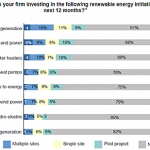 |
| Reviews and Templates for Expression We |
Verdantix Report: 42% Senior Execs Expect to Change Energy Management by 2014
Large-scale energy systems integration has become an important component of financial performance for a number of public and private sectors, including grocery retail, telecom, real estate development, data centers, manufacturing and electricity networks, according to a six-month study conducted by independent analyst firm Verdantix.
Results of the Future of Energy Management report were based on interviews with 210 corporate energy decision-makers, who represent companies in 21 industries. Of those interviewed, which included plant managers, CFOs and building information modellers, 42 percent said they expect significant change in how they manage energy by 2014. Over the next 12 months, these senior energy managers plan to make improvements in energy data collection, program implementation and risk management.
The shift to large-scale energy systems has been driven by higher energy prices, concerns about the security of energy supply, new options for decentralized power generation, creative financing tools for energy efficiency and the potential for innovation at scale through IT platforms, Verdantix Senior Manager Janet Lin said.
Examples of integrated energy systems include the Songdo International Business District in South Korea, a large-scale residential development with integrated resource management systems and a natural gas-fuelled cogeneration plants that powers and heats the district.
Other examples include, the University of Texas in Austin’s 137 megawatt combined heat and power plant; the German power giant RWE’s Rhine-Ruhr 80 MW virtual power plant; and New York City’s Empire State Building, which uses a whole-building control system to monitor and optimize HVAC, lighting and other building features for 85 stories of commercial and office space as well as a web-based tenant energy management system enabled by sub-metering.
Verdantix research released last year found energy management software is creating integration challenges for its users, with companies buying up to eight different applications to meet 12 different usage scenarios.
|
|
|
|
Copyright 2011 Energy and Technical Services Ltd. All Rights Reserved. Energyts.com |